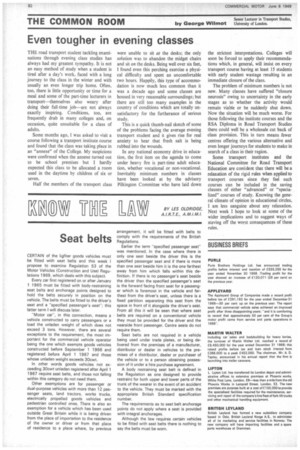Seat belts
Page 84

If you've noticed an error in this article please click here to report it so we can fix it.
CERTAIN of the lighter goods vehicles must be fitted with seat belts and this week I propose to examine Regulation 53 of the Motor Vehicles (Construction and Use) Regulations 1969, which deals with this subject.
Every .car first registered on or after January 1 1965 must be fitted with body-restraining seat belts and anchorage points designed to hold the belts securely in position on the vehicle. The belts must be fitted to the driver's seat and a "specified passenger's seat"; this latter term I will discuss later.
"Motor car", in this connection, means a vehicle constructed to carry passengers or a load the unladen weight of which does not exceed 3 tons. However, there are several exceptions to the requirement, the most important for the commercial vehicle operator being the one which exempts goods vehicles constructed before September 1 1966 and registered before April 1 1967 and those whose unladen weight exceeds 30cwt.
In other words goods vehicles not exceeding 30cwt unladen registered after April 1 1967 require seat belts, and those not falling within this category do not need them.
Other exemptions are for passenger or dual-purpose vehicles with more than 12 passenger seats, land tractors, works trucks, electrically propelled goods vehicles and pedestrian controlled ones. There is also an exemption for a vehicle which has been used outside Great Britain while it is being driven from the place of importation to the residence of the owner or driver or from that place of residence to a place where, by previous arrangement, it will be fitted with belts to comply with the requirements of the British Regulations.
Earlier the term "specified passenger seat" was mentioned. In the case where there is only one seat beside the driver this is the specified passenger seat and if there is more than one seat beside him it is the one farthest away from him which falls within this definition. If there is no passenger's seat beside the driver then the specified passenger's seat is the forward facing front seat for a passenger which is foremost in the vehicle and farthest from the driver's seat, unless there is a fixed partition separating this seat from the space in front of it alongside the driver's seat. From all this it will be seen that where seat belts are required on a conventional vehicle they must be provided for the driver and the nearside front passenger. Centre seats do not require them.
Seat belts are not required in a vehicle being used under trade plates, or being delivered from the premises of a manufacturer, distributor or dealer in vehicles to the premises of a distributor, dealer or purchaser of the vehicle or to a person obtaining possession of it under a hire purchase agreement.
A body restraining seat belt is defined in the Regulation as one designed to provide restraint for both upper and lower parts of the trunk of the wearer in the event of an accident to the vehicle. They must be marked with the appropriate British Standard specification number.
The requirements as to seat belt anchorage points do not apply where a seat is provided with integral anchorages.
Although the law requires certain vehicles to be fitted with seat belts there is nothing to say the belts must be worn.


























































































































